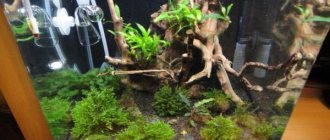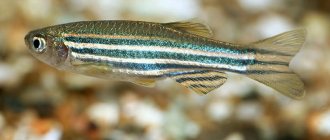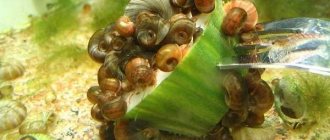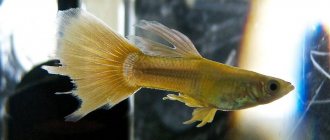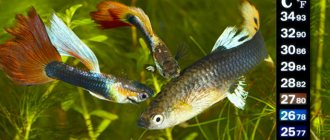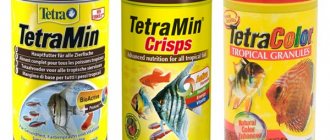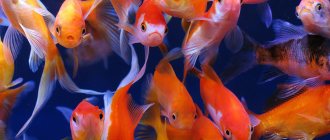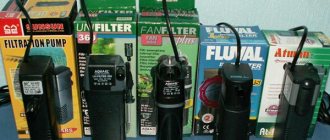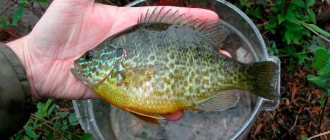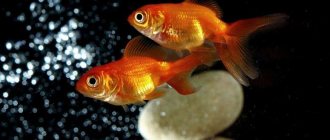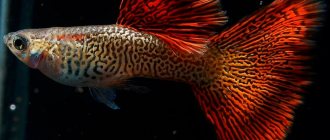Attention! The calculator calculates the most optimal conditions for keeping fish in the most comfortable conditions for them. You can slightly increase the number of fish, provided that you either have excellent water filtration, or regularly change it with a soil siphon, or have a lot of fast-growing plants that absorb trace elements and nitrates from the water, or a combination of these factors.
Beginner aquarists complain that the calculator has too large volumes, but understand one thing, if you do not trust the calculation result, then in the future you will have to deal with algae (beard, flip flop, filament, xenococus), fish diseases (semolina, bloating, ruffled scales , various infections and fungi) and other troubles (white worms).
When calculating the quantity, be sure to take into account the size of adults, and not young animals or fry, and the characteristics of their behavior, fast or slow, love shelters and thickets or open space, etc. And only based on this, calculate the number of fish you like. How to do this correctly? Let's find out below.
How many fish can you put in an aquarium?
The first thing you should pay attention to when calculating the number of fish is the volume of the aquarium and its geometric dimensions. In the literature, one often comes across a rather primitive calculation - 1-2 liters of water are needed per 1 cm of fish length . This method can only be used with reservations:
- When calculating, the size of adult individuals is taken into account, and not the purchased young animals;
- the aquarium must be equipped with a water treatment system and an aerator;
- it is necessary to take into account the layer-by-layer filling of the aquarium, especially when filling aquariums from 30 liters - so that in the end it does not turn out that most fish prefer to spend time in the middle layers, and the bottom and surface layers are empty;
- do not forget that large fish produce a lot of waste, which in small aquariums can quickly render the water unusable;
- From the nominal volume of the aquarium, the volume of soil and decorations, if any, should be subtracted - approximately 15%.
You should also take into account the geometric dimensions of the aquarium - the ratio of width, length and height. For the most part, this indicator will affect the overall aesthetic perception of the filled aquarium, for example, fish with a tall, laterally compressed body (gourami, angelfish, Sumatran barb) look more advantageous in aquariums where the height exceeds or is equal to the length, and the width is small (screen aquarium) . Elongated fish (zebrafish, swordtails) look advantageous in low, long aquariums. For a round aquarium, it is worth giving preference to fish with a voluminous body - varieties of goldfish - telescopes, vole tails.
The disadvantage of this approach to calculating the number of fish in an aquarium is that it does not take into account the characteristics of different breeds , providing only the minimum space for physiological health. This often leads to the fact that some specimens can show aggression towards their neighbors (for example, betta fish); less energetic fish will hide in corners and in algae bushes.
Basic sizes of the most common fish and the number of liters of water required for keeping.
| Size and type of fish | Water volume, l |
| Small - up to 6 cm in length: neons, guppies, platies, some types of barbs, zebrafish, cardinal. | 5-7 liters per couple. |
| Medium - from 7 to 12 cm in length: swordtail, black molynesia, Sumatran barb, rasbora, cockerel, speckled catfish, macropod, gourami. | 30 liters per couple. |
| Large – 15-20 cm in length: goldfish and their varieties, pearl gourami. | 40-45 liters per couple. |
| Very large - over 20 cm in length: discus fish, African and American cichlids, Indian knives, Botia modesta. | From 150 liters per couple and above. |
Care and arrangement of small reservoirs
Small aquariums are comfortable to use, but when arranging and maintaining them, it is necessary to take into account some nuances:
Well maintained aquarium.
- Be sure to install a filter, preferably a pump with a sponge for cleaning.
- Equip the tank with an aerator to saturate the water with oxygen.
- Maintain the desired temperature of even a small container using a heater.
- Equip the backlight (a built-in lamp is suitable).
- Plant plants that will help establish the correct amount of nitrates and ammonia and will serve as a natural hiding place for small pets. Ferns, Anubias, Cryptocoryne, Cladophora, Marsilia blixa, and Brazilian lileopsis are good for a compact aquarium.
- Periodically clean decorative elements and devices from dirt and monitor the quality of their work.
- Be sure to change the fluid weekly with a renewal of 15-20% of the volume. Clean the container with a scraper. Remove dirt, plaque, food debris from surfaces as they become dirty.
Calculation of the number of fish per aquarium volume
When populating an aquarium with fish, you can also focus on the surface area of the water. Calculating the area is quite simple:
- for square and rectangular aquariums, multiply the length by the width;
- for round ones – 3.14*R2, where R is the radius of the aquarium.
Then follow the rule: small fish 2-5 cm with a narrow body require 90 cm2 of area, larger specimens or those with a round body shape - 150 cm2.
The disadvantage of this approach is that, like the first option, it does not take into account the characteristics of different types of fish, such as the amount of waste produced by the specimen, as well as the possibilities for improving gas exchange with forced aeration.
Which rule should I use?
In normal situations, the rule of three liters per 2 cm works quite adequately and is very easy to calculate. If you use this rule, always consider the net volume of water and take into account the size of the adult fish, as well as its shape. If the aquarium is non-standard (round or tall cube), the surface rule works better than the standard three-liter rule. In any case, always make preliminary calculations, and it is better to err on the smaller side than on the larger side.
Also, never populate an aquarium with the entire population at once. It is recommended to fill the container with 25% of the possible permissible amount of fish at a time. Fish waste is toxic, it is processed by colonies of beneficial bacteria, and the bacterial colony needs time to grow and adapt to changes in bio-load. By introducing the fish in stages, the bacteria will have enough time to grow and process the toxins released by the fish.
Calculation of the number of fish taking into account the characteristics of the species
Before buying fish and populating the aquarium, you first need to decide on the species composition of the fish house. Ideally, having compiled a list, show it to an experienced aquarist, who will be able to determine how correctly the pets have been selected, taking into account:
- maintenance conditions (similar temperatures and pH of water, hardness);
- the nature of the selected species - the absence of aggressive breeds, differences in temperament (for example, it is difficult for quiet and calm guppies to get along in the same aquarium with active and frisky Sumatran barbs; it is generally recommended to keep males apart from all fish);
- dividing the inhabitants of the aquarium into layers - 25% should be in the upper and bottom layers, 50% in the middle;
- schooling or individualism of fish - species such as zebrafish, guppies, neons feel good in schools of 6 or more specimens.
It is necessary to select fish of different breeds very responsibly
If there is no one to get qualified advice from, then you should study the information on each species in as much detail as possible, and only then determine the number of fish and their species composition.
Small subtleties
Group effect
It has been noticed that peaceful fish living in schools are much calmer, which means they consume less oxygen than solitary fish. It is recommended to keep such species not even in pairs, but in small “companies”; in this case, their population density can be safely increased.
Dispersal by layers
The aquarium must be populated on all “floors”. If you don’t know what breed the fish belongs to (bottom-dweller, inhabitant of the middle or upper layers), look at its “face”. Turning the fish's mouth downwards will indicate its predilection for “digging” in the ground; it prefers to live in the depths. The fish's mouth is directed straight - its place is in the middle layers, upward - on the surface of the aquarium.
How many fish can you keep in a small aquarium of less than 5 liters?
It’s worth noting right away that keeping fish in such microaquariums is a very troublesome task. It is very difficult to achieve equilibrium in the system; it requires a lot of effort and patience to clean the aquarium and change the water (at least 4 times a week). You can plant a couple of guppies or one cockerel in such a small volume. The cockerel will feel great, but the guppies will quickly breed and the container will become crowded.
3 liter aquarium
Aquariums smaller than 2 liters are not populated by animals, with the exception of some types of snails.
Interesting!
The smallest aquarium was created in Omsk by miniaturists A. Konenko and S. Konenko - in a volume of 10 ml of water they managed to place a nano-compressor, small cladophora bushes and a zebrafish fry.
Optional equipment
In order for the aquarium to function normally and the residents in it to feel comfortable, it is recommended to equip it with the following equipment:
- Filter
- Compressor
- Lighting
- Heater
The filter purifies the water, thereby reducing the frequency of water changes and maintaining the microclimate. To properly set up a 20-liter aquarium, it is difficult to choose a stationary filter; a remote one is more suitable. When choosing a filter, you should take into account its size - in working condition it should be completely immersed in water so that it does not touch the bottom.
It is also important that the power of the filter matches the volume of water.
An excellent solution is to install a remote filter-aerator in a 20-liter aquarium. This device not only purifies water from contaminants, but also returns it already saturated with oxygen, which makes it possible to avoid installing a compressor.
The compressor is no less important than the filter device. It saturates the water with additional oxygen necessary for its inhabitants and plants.
When choosing a compressor, just like with a filter, you need to take into account its size. A large compressor is not suitable for a small aquarium, because... Excess oxygen can be harmful to underwater inhabitants, as can its lack.
Light is necessary both for the normal life of fish (the change of day and night) and for photosynthesis of plants. For some fish, a table lamp is enough. Still, it is recommended to install adequate lighting. But it should be taken into account that the presence of additional lighting and a heater can lead to overheating of the water, which the fish do not like at all. The optimal solution to this problem is energy-saving lamps. The light should not be constantly on or off; fish need a natural change of time of day. Therefore, it is better if the light is on during the day and off at night.
The optimal water temperature for most fish species is from 22° to 26°. But there are also cool lovers (for example, aquarium goldfish) who prefer from 18 to 23°. There are also heat-loving fish, for which a temperature of 27-30° is more suitable. Therefore, the installation of the heater is determined by the room temperature and the type of underwater inhabitants.
Almost any heater can be installed, the main thing is not to forget to monitor the temperature. The device should not be left on constantly, otherwise the water will quickly overheat. In order to monitor the temperature, it is recommended to install a thermometer or a heater equipped with thermoregulation. Such equipment independently monitors and adjusts the water temperature.
How many fish can you keep in a 5 liter aquarium?
It is very difficult to stock very small 5 liter aquariums with fish. The main difficulties lie in maintaining biological balance and the required temperatures, which is more difficult to do in a small volume than in a large volume.
Therefore, for a 5-liter aquarium it is better to choose unpretentious, peaceful small fish - a couple of guppies or a couple of swordtails. Black mollies will look impressive in a small aquarium, but they are more demanding in terms of keeping conditions than the listed fish.
5 liter aquarium
If you want to keep larger fish in a 5-liter aquarium, you can populate it with a beautiful specimen of goldfish, or gourami.
Important!
Please note that large fish do not always look good in small containers. Therefore, the rule is more often used - small aquariums for small fish, large aquariums for large ones.
If you already have an aquarium
If you have an aquarium and there are fish swimming and plants growing there, you can do self-monitoring. Enter your parameters, enter your fish. And find out how your aquarium is balanced in our opinion. How many more fish can theoretically be added? Or in general, you have an overpopulation, and therefore your fish are constantly dying. Anything you buy in addition will not survive.
It's the same with plants. If you have entered the parameters of your aquarium, but the plant that is dying is not there, then most likely you have the wrong conditions. At the very least you will see that the aquarium is not balanced. There are not enough conditions for the plants you plant.
How many fish can be placed in a 10 - 15 liter aquarium?
You can diversify the species composition of a 10-liter aquarium compared to a 5-liter aquarium with bottom fish. Speckled catfish get along well with most species, so a couple of these bottom cleaners will come in handy.
One gourami or a family of bettas (a male and a pair of females) are well suited for living in the middle layer of a 10-liter aquarium. It would be quite nice in such a volume and a flock of neon fish, swordtails, guppies, and mollies. You can take a couple of each of these fish, but they feel more comfortable in schools of 5-7 pieces, so for such a large aquarium it is better to stick to just one species.
10 liter aquarium
Important!
To populate aquariums with a small volume of 10-30 liters, it is better to select small-sized fish - no more than 4-5 cm in length.
When calculating the number of fish for small aquariums, it is important to take into account other inhabitants - for example, large ampullaria snails. They also produce waste that pollutes the system, so snail populations need to be kept under control.
Number of fish for a 10 liter aquarium (table)
| Types of fish | Approximate number of fish, pcs. |
| Guppy | 4 |
| Mollies | 1 |
| Pecilia | 1 |
| Barbs | 1 |
| Danio | 2 |
| Cardinals | 2 |
| Lyalius | 2 |
| Betta fish (bettas) | 2 |
| Tetradons dwarf | 1 |
| Apistograms of Ramiresi | 1 |
| Neons | 4 |
| Ornathus | 4 |
| Ternetia | 1 |
| Tetras | 2 |
| Flashlights | 2 |
| Speckled Corydoratus catfish | 1 |
Shiny neons
The ideal option for an aquarium of approximately 20 liters is peaceful, shiny neons. Thanks to their unpretentiousness, neon chicks will feel great in a 10-liter vessel, but only if their number consists of 4 individuals. It is worth remembering that this type of fish belongs to schooling aquatic inhabitants, so the aquarium should be a little larger.
Paying attention to the appearance of the fish, the distinctive color feature is a shiny blue horizontal stripe, while the body itself has different colors: blue, black, red and blue. By nature, charming neons are friendly, sociable, very active and playful, not picky and not difficult to keep.
Catfish, goopish and minors will be good neighbors for them.
Danio - rerio
Striped aquarium inhabitants zebrafish - rerio, another ideal option for a 20-liter reservoir. In addition to their cheerful multi-colored color, zebrafish are cheerful, agile and very active. That is why they will become a real decoration for a small aquarium of 20 liters.
They are not picky, as they can live calmly in water with temperatures ranging from 16 to 30 degrees, they love vegetation and are content with good natural light. It is preferable to feed with live food, for example, daphnia, cyclops or live bloodworms. They spawn easily and do best in schools.
Friendly guppies
The most common inhabitant of home aquariums, guppies, do not cause any trouble for their owners, which is why they are considered the best option for beginning aquarists. In addition, guppies, in addition to being unpretentious, have many beautiful colors and are fertile. After just a few weeks of living in a 20-liter aquarium, you can find a huge number of fry, which are quite difficult to catch.
Guppies eat absolutely everything and can survive a week-long hunger strike just fine, tolerate absolutely any temperature and can be content with natural light.
But in order for the color of the fish to acquire a more saturated palette, it is worth installing artificial lighting, paying attention to frequent feeding and periodically changing the water, adding approximately 1.5 liters of water to a 20-liter aquarium once a week.
Cardinals
A beautiful slender cardinal, it is considered one of the few fish that feel great in a small aquarium of 20 liters. Cardinals have a beautiful brown-olive hue with a silver tint. The caudal fin is bright red and has small yellow stripes. The cardinal fish in small spaces in the aquarium can reach approximately 4-5 cm.
Cardinals are friendly fish, which is why it is better to keep them in small schools in the company of red neon, zebrafish or rhodostomus. To make the cardinals feel at home, it is necessary to decorate a small 20-liter pond with vegetation. Dry mixtures and live food are ideal as food.
Norman's Blue Eye
The cute schooling blue-eyed fish is an ideal solution for a small aquarium. Experts are confident that even in a 10-liter vessel these fish will be able to swim to their heart’s content. A distinctive feature of the blue-eye is the bright frame of the eye shell, which glows with neon light, thereby making the atmosphere of the aquarium extremely charming.
The peaceful but slightly shy blue-eye will get along with peaceful fish species, but it is better to keep large inhabitants away. The blue-eye loves various shelters, plant thickets, dark soil and a little free space. It eats almost all types of live food and does not disdain substitutes.
Luxurious cockerels
For beautiful betta fish, owners of luxurious fins and bright colors, a pond of a small number of liters is also ideal. However, to keep these fish it is necessary to create certain conditions. For example, too low or too high a temperature can lead to diseases that will lead to the death of bettas. A mandatory condition is to change the water, approximately several liters weekly,
The fish's daily diet consists of live food. You can use frozen food, or dilute their diet with flatworms or snails. They get along with swordtails, minors, catfish, gouramis, etc. But active fish like guppies, neons, and barbs can inadvertently damage the gorgeous fin of a cockerel, which will lead to fighting fights.
How many fish can you put in a 20 liter aquarium?
For 20-liter aquariums, you can safely populate both the top layer of water and the middle and bottom layers. If we take the species and quantitative composition of a 10-15 liter aquarium as a basis, then in a 20 liter aquarium you can add 2-3 zebrafish, but they may be too active for such a small aquarium.
Aquarium 20 liters
A pair of medium-sized labyrinth gouramis are also well suited for keeping in a 20-liter aquarium.
You can keep 1 goldfish, or its varieties - veiltail, telescope, but you need to understand that in such small containers, these species will never grow to the normal size of an adult.
Important!
Most often, small aquariums are bought for children, thinking that it will be easier to care for, but this is not so! All small aquariums require very frequent cleaning, good aeration, which does not create a current, and cleaning, otherwise the fish can die very quickly. Therefore, when choosing an aquarium for a child, it is better to opt for easier-to-care containers of 50-60 liters.
Number of fish for a 20 liter aquarium (table)
| Types of fish | Approximate number of fish, pcs. |
| Guppy | 8 |
| Mollies | 1 |
| Pecilia | 2 |
| Barbs | 1 |
| Danio | 4 |
| Cardinals | 4 |
| Gourami | 2 |
| Lyalius | 4 |
| Macropods | 1 |
| Betta fish (bettas) | 4 |
| Tetradons dwarf | 2 |
| Apistograms of Ramiresi | 2 |
| Neons | 8 |
| Ornathus | 8 |
| Rhodostomus | 6 |
| Ternetia | 2 |
| Tetras | 4 |
| Flashlights | 4 |
| Speckled Corydoratus catfish | 1 |
| Swordtails | 2 |
Conditions of detention
Aquarium fish, like all living things on earth, need oxygen. Since we are talking about a limited space, the lack of water, and, consequently, the oxygen contained in it, can have a detrimental effect on the health of the fish.
Another factor to consider is living space. In overcrowded reservoirs, even non-aggressive fish can experience conflict situations. Fish with bitten tails and fins will not decorate your aquarium.
The size of adult individuals and their feeding activity are also important. Larger fish produce more waste, resulting in higher levels of toxic nitrogen-containing products in the aquarium - nitrates, nitrites, ammonia.
Signs that may indicate overpopulation:
- fish swim to the surface and gasp for air or stay in the thickets of plants;
- the inhabitants of the aquarium have a paler color;
- poor growth gains, fish raised in cramped aquariums rarely reach the size characteristic of this species;
- lack of offspring.
The situation with overpopulation can be partially solved by additional means - blowing water and powerful filters, frequent changes of water and a slight decrease in its temperature - within normal limits for these types of fish, of course. Planting living plants will help saturate the water with oxygen; it is important not to overdo it - in dense plantings it will be difficult for fish to move, and it will be difficult to see them.
By observing all these conditions, it is possible to solve problems with overpopulation or increase population density. But it should be remembered that an aquarium filled to capacity is unlikely to serve as an aesthetic spectacle.
How many fish can you put in a 30 liter aquarium?
In such an aquarium you can already expand - make larger schools of fish, since most small fish look good among their relatives - about 10 neon fish and about 6 thorns, a couple of catfish. You can diversify the species composition with shrimp; most calm, medium-sized fish get along well with them.
You can populate the aquarium with a flock of 3-5 barbs, not forgetting that these bullies like to leave quiet guppies without fins.
Aquarium 30 liters
Most often, aquariums up to 30 liters are considered by professional aquarists only as spawning grounds, or for raising young animals, which will then be transferred to a larger house. Therefore, such aquariums do not shine with a variety of species - to keep them it is necessary to select the most unpretentious fish.
Number of fish for a 30 liter aquarium (table)
| Types of fish | Approximate number of fish, pcs. |
| Guppy | 12 |
| Mollies | 2 |
| Pecilia | 3 |
| Barbs | 2 |
| Danio | 6 |
| Cardinals | 6 |
| Gourami | 2 |
| Lyalius | 6 |
| Macropods | 2 |
| Betta fish (bettas) | 7 |
| Tetradons dwarf | 2 |
| Apistograms of Ramiresi | 3 |
| Neons | 12 |
| Ornathus | 12 |
| Princesses of Burundi | 1 |
| Rhodostomus | 8 |
| Ternetia | 3 |
| Tetras | 6 |
| Flashlights | 6 |
| Speckled Corydoratus catfish | 2 |
| Swordtails | 3 |
Decorative elements
To create an original design for a 30-liter aquarium, you need to take care of decorative elements. Thanks to decorations, you can decorate an artificial pond in a different style. The following elements are used for these purposes:
- various “wallpapers” for the back wall of the aquarium;
- driftwood;
- shells;
- locks;
- ship models and more.
After recreating the atmosphere of the underwater kingdom, it’s time to think about what kind of fish to put in an artificial pond and how many snails should be in the aquarium.
Settling the aquarium
You can keep several types of fish in an aquarium, but if you wish, it is permissible to limit yourself to one breed, the main thing is not to overpopulate the artificial reservoir. The most common species that are suitable for keeping in a small container are guppies. With a capacity of 30 liters, up to 20 individuals can comfortably exist in the container. In addition, artificial reservoirs are populated with the following species of small fish:
- platies, molinesias and swordtails (up to 10 individuals);
- cockerels and macropods (most often these species are kept alone, but since 30 liters of space is a lot for one individual, you can choose fish that can exist next to them as neighbors);
- catfish (5 individuals each);
- tetras and thorns (no more than 10 fish).
If there is a desire to create a reservoir with a “combined” population, it is recommended to select individuals in this way:
- Sumatran barbs (5 pcs.), mossy barbs (10 pcs.), speckled catfish (3 pcs.);
- neons (10 pcs.), ancitrus catfish (3 pcs.), mossy barbs (5 pcs.), zebrafish (4 pcs.);
- zebrafish (5 pcs.), guppies (10 pcs.), white catfish (3 pcs.);
- mollies (5 pcs.), swordtails (5 pcs.), neons (10 pcs.), ancitrus catfish (3 pcs.).
Often other types of underwater inhabitants are added to the fish. How many snails are allowed in a 30 liter container? As a rule, 10 of these individuals are enough.
Keeping fish and decorating aquariums is a fascinating activity. With some creativity and some effort, you can turn even a small “house” into a real work of art.
Look at the beautiful inhabitants of this small house.
https://youtube.com/watch?v=6ZLQH1nSmCY%3F
How many fish can you keep in a 40 liter aquarium?
For aquariums of 40 liters, it is already possible to select a wider range of species, including larger specimens: various types of gourami, except large pearl ones, dwarf tetrodons, lalius, macropods. A couple of large fish, a couple of bottom-dwelling catfish and a flock of 5-7 small fish - guppies, neon fish - are quite a sufficient number of inhabitants of a 40-liter aquarium.
Aquarium 40 liters
Important!
Since small aquariums can easily be overpopulated with fish, it is recommended to buy and add them to the aquarium in parts - for example, you bought a flock of guppies - stocked them, waited 2-3 days - bought gourami - stocked them, waited again. During this time, you can take a closer look at how the pets feel, how harmonious the aquarium looks with the fish already added, and, if necessary, stop and not buy the next batch.
This method is difficult to apply only in cases of purchasing young fish, when the fish have not yet reached adult size.
Number of fish for a 40 liter aquarium (table)
| Types of fish | Approximate number of fish, pcs. |
| Guppy | 16 |
| Mollies | 3 |
| Pecilia | 4 |
| Barbs | 2 |
| Danio | 8 |
| Cardinals | 8 |
| Gourami | 3 |
| Lyalius | 8 |
| Macropods | 3 |
| Betta fish (bettas) | 10 |
| Tetradons dwarf | 3 |
| Apistograms of Ramiresi | 4 |
| Neons | 16 |
| Ornathus | 16 |
| Princesses of Burundi | 1 |
| Rhodostomus | 10 |
| Ternetia | 4 |
| Tetras | 8 |
| Flashlights | 8 |
| Speckled Corydoratus catfish | 4 |
| Swordtails | 3 |
Pros and cons of small volumes
More often, small aquariums are chosen by beginning aquarists, believing that they are easier to maintain than large ones. But this option has both advantages and disadvantages.
The first include:
- space saving;
- low cost;
- cheap service;
- minimum decor;
- mobility.
To the second:
- cloudiness of water;
- discomfort of the inhabitants due to lack of oxygen;
- difficulty in establishing biological balance;
- frequent, sudden changes in water temperature;
- rapid evaporation;
- difficulties in locating the necessary equipment;
- limited choice of inhabitants.
Space saving and low cost of the aquarium are advantages.
How many fish can you keep in a 50 liter aquarium?
In aquariums of this size it is already permissible to contain one labeo, a couple of schools of small fish of 7-9 copies, 3-4 catfish. It is imperative to take into account that if viviparous animals, such as guppies, swordtails, and Malinesias, are kept together with large fish, then the large specimens will happily eat the fry, considering them food, so special aquariums for the fry will be needed.
Aquarium 50 liters
A good water purification system and aeration, more powerful than in smaller aquariums, allow you to populate a 50-liter aquarium with more fish than expected.
Number of fish for a 50 liter aquarium (table)
| Types of fish | Approximate number of fish, pcs. |
| Guppy | 20 |
| Mollies | 4 |
| Pecilia | 6 |
| Barbs | 4 |
| Danio | 10 |
| Cardinals | 10 |
| Goldfish | 1 |
| Gourami | 4 |
| Ctenopomas | 1 |
| Lyalius | 10 |
| Labiosis green | 1 |
| Macropods | 4 |
| Betta fish (bettas) | 12 |
| Tetradons dwarf | 5 |
| Apistograms of Ramiresi | 5 |
| Neons | 20 |
| Ornathus | 20 |
| Common piranha | 1 |
| Princesses of Burundi | 2 |
| Rhodostomus | 12 |
| Ternetia | 5 |
| Tetras | 10 |
| Flashlights | 10 |
| Acantophthalmus | 1 |
| Ancistrus | 2 |
| Speckled Corydoratus catfish | 5 |
| Badisy | 2 |
| Swordtails | 4 |
Plants
Plants are needed for natural filtration and to create shade for secretive fish. Greens are involved in many biological processes taking place in a body of water, for example, absorbing carbon dioxide or harmful inorganic compounds. Beautiful and unpretentious plants:
- Elodea;
- Cryptocoryne;
- Java moss;
- Hornwort;
- Heteranthera doubtful;
- Yakut.
How many fish can you keep in an aquarium 60 - 100 liters
Aquariums with a volume of 60 to 100 liters are already large enough to contain larger fish with a body length of 15-20 cm. When calculating the number of inhabitants, it is better to adhere to this principle - first select large breeds from 2 to 4 pieces depending on the volume (this can be gourami, cichlids, goldfish, labeo), and then they select several species of bottom fish and several top-level fish, buying them in schools, and always taking into account compatibility with the selected large fish.
In this volume range of 60-100 liters, it is very easy to get carried away and overpopulate the aquarium, especially when you initially buy young animals and until they grow up, the aquarium looks empty. It is important to clearly define the species you want to keep and stick to your choice, otherwise the aquarium will turn into a “fish hostel” with an endless flurry of all sorts of shapes and colors. In such conditions, the fish will suffer from constant stress, which will affect their appearance and well-being.
70 liter aquarium
It is imperative to take into account that large fish tend to choose a corner to their liking and protect it from the invasion of strangers, so a corner, for example, occupied by a pair of angelfish must already be deleted from the total volume of the inhabited territory. Barbs, on the contrary, tend to spread throughout the aquarium, giving no rest to slower fish, starting fights and bullying everyone and everything.
Number of fish for an aquarium per 100 liters (table)
| Types of fish | Approximate number of fish, pcs. |
| Guppy | 45 |
| Mollies | 12 |
| Pecilia | 12 |
| Barbs | 10 |
| Danio | 20 |
| Cardinals | 20 |
| Goldfish | 2 |
| Gourami | 7 |
| Ctenopomas | 2 |
| Labeo | 2 |
| Lyalius | 20 |
| Labiosis green | 2 |
| Macropods | 10 |
| Betta fish (bettas) | 25 |
| Tetradons | 2 |
| Tetradons dwarf | 10 |
| Cockatoo Apistograms | 4 |
| Apistograms of Ramiresi | 10 |
| Neons | 35 |
| Ornathus | 35 |
| Common piranha | 1 |
| Parrot | 1 |
| Princesses of Burundi | 4 |
| Pseudotropheus | 2 |
| Rhodostomus | 24 |
| Ternetia | 10 |
| Tetras | 20 |
| Flashlights | 20 |
| Acantophthalmus | 2 |
| Ancistrus | 2 |
| Yulidochromis Regan | 1 |
| Speckled Corydoratus catfish | 10 |
| Sacbranch catfish | 1 |
| Catfish Tarakatuma | 1 |
| Badisy | 4 |
| Swordtails | 6 |
What is the threat of overpopulation?
If there is overcrowding in the bank, the fish will begin to suffer from a lack of oxygen, which will negatively affect their health. In addition, a struggle for living space will begin, which can lead to damaged fins.
Large fish release a lot of waste into the water, which leads to an increase in ammonia, nitrates and nitrites. Because of this, pets can die.
Of course, you can install a powerful external filter in an overpopulated aquarium, change water more frequently, and plant a lot of plants. In this case, the fish will not be poisoned and die. But will they be comfortable? Of course not. And you are unlikely to like an aquarium densely populated with fish.
How many fish can you keep in an aquarium larger than 150 liters?
In large aquariums from 150 liters it is better to keep large specimens of fish - cichlids (acara, cichlosoma), goldfish, labeo, and from the bottom - ancistrus. Small breeds will simply get lost in a large aquarium.
In a 150 liter aquarium you can keep:
- up to 10 pieces of small cichlids or 8 pieces of large ones;
- labeo 4-5 pieces;
- large specimens of goldfish - 3 pieces (their smaller number compared to other species is due to the fact that they produce a lot of waste products, which upsets the balance in the system);
- large specimens of pearl gourami 8 pieces;
- a couple of large catfish, such as the sacbranch catfish.
Aquarium 200 liters
It should be borne in mind that the actual volume of a large aquarium will always be less than the declared volume by even more than 15%, since in large aquariums it is customary to place more decorations, driftwood, stones, which also takes up a certain volume.
In 200 liter aquariums you can already accommodate a couple of discus fish. It is not recommended to add anyone other than bottom-dwelling catfish to them, since discus fish require high temperatures, which is not always good for other fish species.
In a 300 liter aquarium, discus can be diluted with a flock of iris - 3-5 pieces.
Ecologically clean living environment
The water in any aquarium should be clean, not contaminated with bacteria and harmful microorganisms, of moderate hardness, without chlorine and excess heavy metals, and saturated with oxygen.
To ensure that the water is soft and free of harmful chlorine, it is left to stand in an open container (for example, an enamel bucket or large saucepan) for 1 day, then boiled, cooled to room temperature and poured into the aquarium. In the future, you can simply add distilled water to the aquarium.
It is necessary to plant beneficial algae in the aquarium. Elodea algae fights well against harmful excess heavy metals. They accumulate zinc especially intensively. Vallisneria is good at purifying water from rust.
How many fish can be kept in an aquarium from 300 to 1000 liters
Great attention must be paid to selecting fish for such large aquariums. Most specimens, having reached their adult size, will eat everything that can get into their mouth, so there is no point in “dilute” the inhabitants of the aquarium with small fish - they will all turn into food. Therefore, it is worth stopping at one species and populating the aquarium with the number of individuals that the volume allows.
Aquarium 500 liters
Suitable for aquariums from 300 liters:
- pterygoplix brocade;
- astronotus;
- African cichlids;
- silver arowana;
- Indian knives;
- discus,
- large sucker catfish.
All these fish grow to very large sizes, so they require from 100 to 300 liters per specimen.
Often, when the tank volume is over 300 liters, the aquarium is made into a marine one and is stocked with fish typical of coral reefs - clownfish, surgeonfish, yellow zebrafish, and chrysiptera sapphire. The number of fish in a marine aquarium is calculated as follows: 35 liters of water per 10 cm of small fish and 5 cm of large fish.
Number of fish depending on the volume of the aquarium:
| Aquarium volume | Recommended number of fish |
| 5 l | 2-3 small fish or a couple of medium ones (in particular swordtails, other species may be less able to tolerate small volumes) |
| 10-15 l | A pair of medium-sized fish or 5-7 small ones |
| 20 l | 2 medium-sized fish, 1 medium bottom fish, 2-3 small fish |
| 30 l | 10-16 small and a couple of bottom ones or 3-5 medium ones and a couple of bottom ones |
| 40 l | 2 large, 2 bottom and 5-7 small |
| 50 l | 1 large and 10-15 small and 3-4 bottom |
| 60-100 l | 2-4 large and 3-4 bottom and 10-15 small |
| More than 150 l | 8 large |
| 200 l | 2 very large |
| 300 l | 2 very large and 3-5 medium |
| 300 – 1000 l | Depending on the type of fish. |
Aquarium soil calculator
Let's calculate the required amount of soil for a rectangular or square aquarium. To do this, we need the length, width of the aquarium and the height of the gravel layer in centimeters.
Aquarium width (cm):
Thickness of the soil layer in the aquarium (cm):
Recommendations for choosing the thickness of the soil layer:
- Aquarium with plants with a powerful root system - 5-10 cm
- Aquarium with small plants with a root system - 3-5 cm
- Aquarium without plants or with plants that do not take root in the ground, cichlids - 1-2 cm
conclusions
- When starting a thirty-liter aquarium, be careful about its maintenance. There is no established biological environment in a small volume, so you need to monitor the purity and parameters of the water.
- Decide in advance which fish to put in the 30-liter aquarium. Take care of the compatibility of temperament and water parameters.
- Do not overcrowd the aquarium, because diseases spread when there is not enough free space. Aggression from some species also occurs in close quarters.
- Monitor the health and behavior of the aquarium inhabitants. If fish gather in groups near the surface, this indicates a lack of oxygen. You will need a compressor and additional plants.
- Inspect and count fish while feeding.
Previous
AquariumHow to clean an aquarium: 8 steps for proper cleaning
Next
AquariumWhy is a round aquarium absolutely not suitable for goldfish?
